|
How to realize living and eloquent pictorial works?
GOETHEANISMUS AND CREATIVE FORCE OF COLOUR
In his Theory of Colours, Goethe hopes that painters should make their own the moral action of colours he made clear in order to make their works more lively and touching.
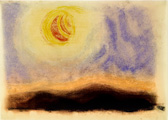 |
|
Rise of the Moon -
R.Steiner*
|
Rudolf Steiner too sees in Goethe’s lesson a host of useful knowledge for renewing painting. He himself deepens Goethe’s theory and widens it with other forms of knowledge, acquired through his own research.
Steiner did above all the very important discovery of the intimate sensations that could be defined as “movements of the soul” which, on contemplating colours, are felt in the depths of the subconscious. They are, as mentioned above, comparable with the dynamic forces of expansion and contraction and, when they are reproduced in the use of colour during painting, they confer on it life and luminosity.
Then Steiner also added to complete the circle of colours of Goethe other colours that are peach flower, white and black. They all are considered as colours in their own right. Finally he distinguished, among all the colours of the circle, the “splendour colours” and the “image ones”, according to their quality and what they expressed.
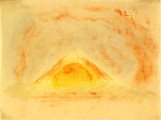 |
|
Sunrise – R.Steiner*
|
This new knowledge offered unimaginable possibilities for the further development of figurative art and Steiner went on to promote profound research by painters, on whom he was lavish in making concrete suggestions and in offering ever new impulses.
Nevertheless, he only gradually conceived during the progress made in personal discovery those steps to be made and so too the most suitable procedures to adopt to obtain the wealth of contents and sensations that can be offered by the use of colours. This took place especially during the execution of the inspiring frescoes realized according to his project in the two cupolas of the “Gotheanum” building (1914-1918). (Unfortunately the works were destroyed by fire, but have recently been recreated and renewed in the large hall of the new “Goetheanum”).
Many painters worked on the frescoes under his supervision, but Steiner did some parts in person.
To start with, large surfaces of colour were painted in a Goethean circular way, appearing as fluctuating currents of colour seen as primordial forces creating images. The images had to be born within the colour and not conceived intellectually
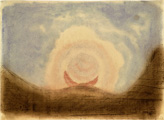 |
|
Setting of the Moon – R. Steiner*
|
Steiner commented on the matter once with. “
When painting the small cupola of the Goetheanum, we did not start from thought out figurations on which colours would later be stuck on, but first we lived through an experience of colours and these gave birth to the figurations. Through the dedication of the colours, we strengthened the creativity of the soul that dreams up images provided by the living colours. In moments of creativity, we felt that nothing else existed in the world apart from the colours which live and weave and which are also creators and generators of essentiality
.” (GA 36-IV “The Goetheanum in its ten year life time”):
On another occasion he further added: “
When painting this cupola I had not a mind to draw this or that motive on the wall, but instead, for example, to have a patch stain of orange with various shades; this gave rise to the figure of a child. Elsewhere I realized that the blue was marked off and this gave me the figure of Faustus. .. The essential character of the figure was completely drawn from colour.
” (GA 290 “The informative idea in the construction of the Goetheanum”).
Thus a new and different way of painting was born, that meant such a complete overturning of usual procedures. It, however, required that artists should adopt a more refined sensibility in the perception of the quality, nature and dynamisms of colours.
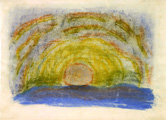 |
|
Sunset - R.Steiner*
|
The particular way to proceed that he thought up, above all the principles that underlie it, is best illustrated on the several occasions in which Steiner himself produced as examples simple pastel works that represent aspects of nature. He intended to show by them a different approach to colours insofar as, by their selection and even with their position in space, they did not have the function of reproducing visible reality, but instead of expressing an intimate relationship with soul experiences, aroused by the observation of the event shown. In this way the resulting image could be lived interiorly.
R. Steiner expressed himself thus on the way to handle colours, to lead their movements and to create forms and therefore figures: “
Nature encourages us everywhere to transform, metamorphose its forms into others. Whoever simply observes nature and copies it falls into naturalism. Whoever lives nature and does not stop just at observing the lines and colours of trees, but lives in them, can obtain from each tree, each animal, each rock another form to impress on the material. We modern people must create works of art in which the form expresses more than the naturalistic one … We must come to see what there is artistic about nature, what in nature brings the form to life, so as to obtain a life in the form higher than the one existing in nature itself.
” (GA 257 “Formation of the community” 22.2.1923.).
 |
|
New Life - R.Steiner*
|
THE IDEA IS BORN FROM COLOUR
The description of an example carried through in front of painters offered by the painter Louise von Blommenstein in her article “Wie Rudolf Steiner vor uns vormalte” (How Rudolf Steiner painted before us) is interesting for a better understanding of the procedure adopted by Steiner. She describes how Steiner spread a delicate blue on a white sheet curving upwards and put a yellow dot alongside. This needed the addition of a complement, so Steiner placed a small lilac spot alongside the yellow one. He showed in this way that a “chord” (a “totality” as Goethe would say) was achieved. Now it was necessary to add a fourth colour that was not part to this chord. So he ringed it with a pale green and then after added violet at the bottom, linking it to the blue. There was a small white area left that he thought needed filling with one of the colours of the chord, a pale blue. The result was a symphony of colour that he rounded off by inserting a reddish colour in the yellow.
Then Steiner began to draw figures, taken out from the gestures and forms that had been consolidated, until a woman’s face appeared and on which he drew the eyes. The form of the lilac suggested another small head, that of a child. The IDEA, a MOTIVE was beginning to appear: mother and child. At this point the idea had to be elaborated and completed by incorporating it in the chromatic whole. He needed to find the link between the two figures and he did this with a stroke of warm colour (orange), which took on the aspect of an arm and a hand. Steiner reworked and harmonized the whole again and finally, with sweeping strokes, inserted a luminous yellow in the background running from the top and placed over the green, so creating a gilded atmosphere.
The work fell into four phases: 1) the experience of resonance of the three colours (chord, totality); 2) the enrichment of the composition with the addition of other colours; 3) the arising and incorporation of the IDEA; 4) the final harmonization of the whole.
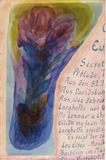 |
|
Primordial Plant - R.Steiner*
|
The following words of Steiner well describe the essence of this new way of painting: “
… if we immerse ourselves in the fluctuating world of colours and live it correctly … we can find that figures emerge from it that come to express the secrets of the universe, the soul of the universe. A world will arise from the creativity of colour, which will configure and differentiate internally, a world that has its own essentiality. The form will arise from the colour. One will perceive that one not only lives in the colour, but that the colour generates the form of itself, that is the form is the work of the colour
” (GA 287 “The building of Dornach as a sign of the historical becoming and artistic impulses of transformation” 25.10.1914).
Steiner summed up the quintessence of the painting procedure he proposed with the motto:
“AUS DER FARBE HERAUS MALEN”
"PAINTING EXTRACTING FROM COLOUR“
WATER COLOUR
Many of the examples traced out by Steiner where done in pastels for practical and time constraints. He nevertheless always maintained that the ideal medium for this type of paining was watercolour. Its luminosity and lightness, despite numerous overlappings and shadings realized with this different technique, allowed for the “freeing of the colour from its burden”.
He himself painted large scale water paintings with intense colours that were nevertheless both transparent and luminous.
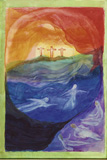 |
|
Easter – R.Steiner*
|
It seems to be obvious that the method Steiner proposed was completely original and certainly still open to unimaginable developments. Even if affinities with impressionism, expressionism and abstractionism often appear, one should not think at all that in some way the Steinerian conception was derived from those currents, but rather that certain essential aspects of them ran parallel with Steinerian thought. One may say that the Steinerian, Anthroposophical or Goethean method of painting, as on likes to call it, appears like an important milestone in the sphere of contemporary art.
One can also state that the novelties offered by the Steinerian method and the possibility of further future developments implicit in it, make this original conception of figurative art a full blown type of avant-garde painting.
Among them, the “school” of Beppe Assenza, who developed a practical, well articulated and deeply though out method, has gained great prominence.
The method of Beppe Assenza is the one followed by Luciano Balduino.
More details concerning the Master Beppe Assenza and his method will be provided in the following sections.
|






